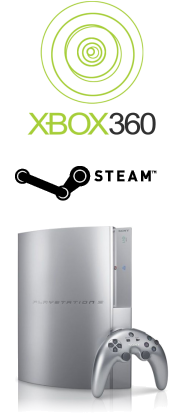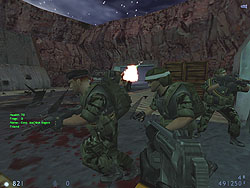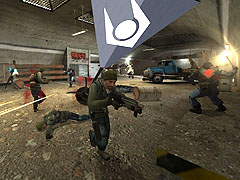Steam vs. World of Warcraft
This article has been imported from The Steam Review’s previous host, and has had its original posting date retained.
Friday marked the final day of 1UP’s Valve week, with the feature’s climax being an interview with Gabe Newell. Frustratingly, the Steam segment is split between the two video files.
This article will consist of a transcript of the interview followed by an analysis of its implications.
Transcript
Sections unrelated to Steam removed
Changing the Game: Episodic Content via Steam (7:18)
Video 1
There were two big, painful periods for Steam. One was when it went from being optional to be the way that everybody needed to get updates, that was pretty painful for people. And then the Half-Life 2 launch where we got swamped with not having enough capacity. Those are both painful memories for us. At least right now we’re not setting anybody on fire: we seem to be getting updates out on a really regular basis…that process [is] really smooth right now.
Right now we’re rearchitecturing Steam. People are actually running two versions of Steam right now — they might not realise that but they are running Steam 2 and Steam 3 alongside each other. The nice thing about having a system like this is there’s no reason not to have your old system and new system co-exist while you’re migrating functionality from one to the other.
One of the problems we had was architectural problems that made Friends unreliable, and so the new version’s approach to connections and how it manages connections should make Friends a lot more reliable. So just from a technical perspective it’s evolving, and from a not-annoying-the-hell-out-of-our-customers perspective I think we’re out of that hole. It’s certainly turned out to be a great way to sell products: we were worried that people might not want to purchase products that way and now that’s not really a concern of ours.
Video 2
I think what we have to do is continue to look for ways to make Steam more valuable to people, to solve problems for people. There are huge numbers of support problems that we can just make go away by proactively solving them, but [for example] we still aren’t getting display drivers out to people automatically which makes me crazy. One of the biggest problems out customers have is that they don’t have an automatic update facility for display drivers, and it’s been obvious for a couple of years that that needs to happen, yet we still don’t have that.
Steam is the Future: The Next-Gen Headache

(2:03) When I look at what I need to compete with, the most interesting game property right now is World of Warcraft. Huge retail sales and huge recurring revenue, and not only that but they have a great experience wrapped around them, whether it’s their forums or community art or whatever. They’re not only getting their customers to play the game, they’re getting their customers to make the experience more valuable for other people who play the game. So I’ll go off and download music and watch the movies that people have created and see fan art and all these other things: when I look at what a platform needs to help a software developer do right now, it’s figure out how to beat World of Warcraft. And when I look at the strategies that are being put forward by Microsoft on the systems side, the Xbox side, Sony, or Nintendo, they’re not making my life easier.
The Playstation 3 makes my life as a software developer much harder…[parallelism] was not a problem that we were lying awake late at night for, saying ‘oh, we would really like to take this on right now’. We were worried about little things like billing, and forums, and Wikis, things like that…Steam, essentially, was ‘here’s a set of tools that software developers need, focused on solving the problems we have with this next generation of games’. Billing, updates, product support, connecting our customers together, things like that. I would think that for a lot of developers things like Steam are going to be more interesting and will solve more problems for them than this next generation of hardware and operating system platforms.
The [Sega] Saturn came out and that was intended to take this previous generation of games and create this super-complicated chunk of hardware that would help you make the ultimate sprite-orientated game. Then Sony came along and said ‘no no no, it’s not a sprite problem any more, it’s a 3D graphics problem’. I think that a lot of developers are going to say [to the next generation] ‘that’s not the problem, that’s another Sega Saturn’. What we really need are [solutions to] ‘how do we connect to our customers, get updates to our customers, have closer relationships’. ‘How do we compete with the customer experience that you get out of being a WOW customer’ more than ‘how do we blast another set of pixels at what is essentially a 640 by 480 screen’.
Analysis: Steam vs. World of Warcraft
Gabe’s interview gives us the new or newly invigorated Steam strategy: to help developers make games, not game technology. It is a plan is in direct opposition to that of the upcoming consoles. Hardware independent, with little to no additional workload and the opportunity to oust the middlemen, Steam is to become even more the platform developers, not publishers, want in the next generation.
In the most general of terms Valve want to achieve this by ‘making Steam more valuable to people’, and Gabe identifies two key areas where this will be attempted. The first and largest is what he terms the ‘customer experience’ — the parts of the community a player experiences; everything about the game except the game. Steam can’t make your title interesting, but it can emulate the many of the MMORPG characteristics that help make World of Warcraft’s customer experience so compelling without you actually making one.
Chief amongst these is communication, both player to player and thanks to the direct and constant link to them player to developer. Friends, when it works, is the clearest example of Steam’s inter-player communication — anyone anywhere anytime, including from single-player games and the desktop — while Valve’s weekly Update News items are examples of player-developer contact and the HL2:CTF matches between Valve and the mod’s developers the first sign of attempts to merge the two. Also attempting to bridge the gap are Ritual, who look set to take a slightly different approach with their community-based outcomes for SiN Episodes, where the in-game decisions a player makes count as a vote towards what will happen in future releases.
The second area is one where Steam has a distinct advantage given its status as a background app as opposed to a self-contained game like WOW. The idea of driver autoupdates hark back to Steam’s inception when it was claimed that both ATi and nVidia were ready to use Steam to deliver their software. The deals fell though (probably due to the atrocious state of the network back then) but now it seems they are back on the agenda. The reasoning behind such a feature is reducing the support burden of people with outdated video card drivers, something Valve do in their own territory with a brief version check before a Source game runs. This proactive approach to troubleshooting is to be expanded to cover Steam itself, with a future feature to diagnose as many identifiable problems as possible, and beyond.
The two big assumptions with this take on the industry are that developers think like Gabe does, and that customers think like Gabe does. The latter isn’t as big an issue as you might expect, with Steam changing market perceptions and introducing a try-before-you-buy model that is available and immediate to every customer. Nobody will browse to the Steam store and pick a game based on its screenshot and blurb like they would at a retailer — they will download the demo first, assuming it exists, and get a taste of the actual game.
Developers, too, are a surprisingly small problem. Those who are or become interested in Steam have already abandoned the system where pretty screenshots alone sell games, and surely in many cases will have abandoned the system where the resources to make those pretty screenshots are available to them. All that’s left to do is make the games.
So we’ve talked about what Valve are doing in the future, but have yet to touch on how. I’ve already made it clear what I think should happen, and if you will excuse my self-indulgence now is the time to look at the evidence and try to predict what will happen. There are many possible moves that are in the spirit of Gabe’s words, but I will keep the list solely to what I can pin on something that has already happened or been announced. Confirmed features will also been omitted.


The Natural Selection and Sven Co-op teams have both been approached by Valve with offers for Steam hosting.
3rd-Party Plug-ins
“I think what we have to do is continue to look for ways to make Steam…solve problems for people.”
Valve can’t solve the problems they don’t know about, but the chances are the people who are having them can. Besides problem solving, allowing plugins increases Steam’s value to plug-in users and generates a whole new community around their development. It is also a natural use for VGUI — if nothing else plug-in support would allow future mods to extend to the desktop, useful for persistent worlds. While plug-ins may create a security risk, it is worth noting that mods are essentially engine plug-ins but pose no such threat to Source. Nevertheless plug-ins would be a large step, one that is unlikely to be taken in one stride.
More mod adoptions and map additions
“They’re not only getting their customers to play the game, they’re getting their customers to make the experience more valuable for other people who play the game.”
Where Blizzard has fan fiction and homemade videos of a character’s epic quest, Valve has mods and maps. Both already fill the brief of increasing value, but only to those who go out and find them. Steam is made for bringing Valve’s content to a gamer’s desktop and according to this new outlook, the community’s content is just as important. The HL2DM map contest shows that Valve are not opposed to the idea of taking on others’ maps, and the Natural Selection and Sven Co-op mod teams are already known to have been approached with offers of adoption.
Official ‘Add-Ons’
Add-On is a new term coined at the release of the Half-Life High Definition pack: optional content that can be enabled and disabled on a whim. The feature is decidedly basic in its current state, and it is more than likely to see improvement in 3.0. Driver autoupdates may well use a version of this feature.
Match broadcasts
The most interesting feature of SourceTV to me is its ability to relay the broadcast to other servers, distributing the load across an unlimited number of machines for a potentially unlimited number of spectators. Add this to a communication tool as powerful as Steam and what else could happen? The first major broadcast has already been announced: the HL2:CTF match linked to earlier. It isn’t a great leap of imagination to see a new page in Browse Games or whatever replaces it covering scheduled matches across the network from week to week.
Conclusion
I hope I’ve provided a fairly accurate and comprehensive dissection of what we can expect from Steam as the industry enters the next generation. Valve clearly see it as much a next-gen platform as the Xbox 360 and PlayStation 3, but focused on solving the problems of those making the games rather than those promoting them. Whether or not they succeed depends on their understanding of what a community wants and needs — something that Valve do not have a particularly good reputation for. Here’s to that changing.




3 Responses to this post:
Comments
WaltDe Says:
Keep up the great work on your blog. Best wishes WaltDe
2 Trackbacks/Pings
Building communities through residency - The Steam Review
Day of Defeat: Source ‘Free Weekend’ - The Steam Review